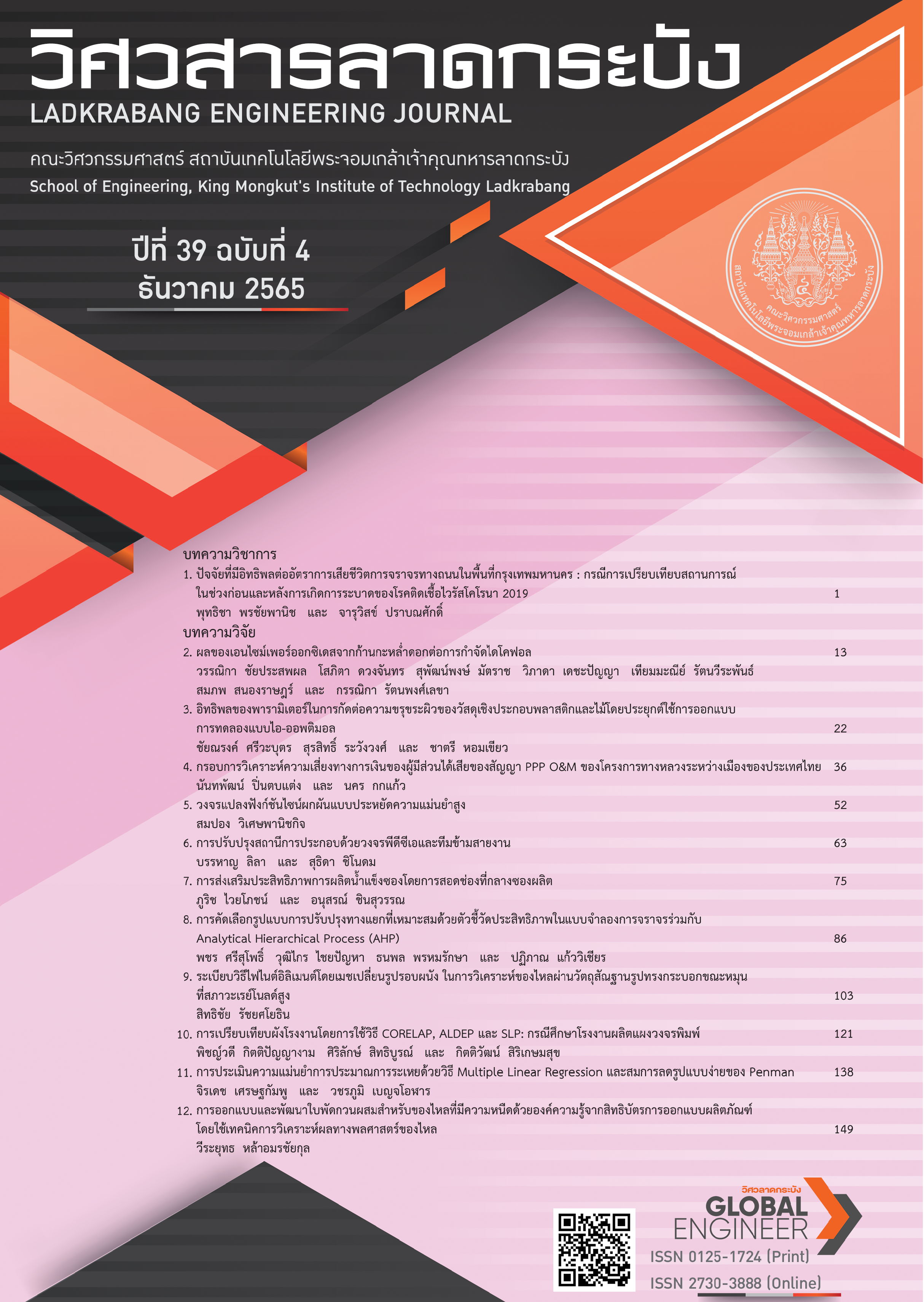The Finite Element with Near-Wall Deformation Mesh Method in the Prediction of Flow Past a Rotating Isolated Cylinder at High Reynolds Number
Keywords:
Finite Element Method of Fluid Dynamic, Rotating Grooved and Cylinder with End Discs, Turbulent ModelAbstract
The computational study has presented the 3D convective turbulent flow past a rotating isolated cylinder at a Reynolds number of 100,000, for spin ratios growing up to 2. The rotating cylinders have plain and grooved surfaces, moreover, the combination with end discs has been purposed in the investigation. The high Re k-e turbulent approach, including the linear approximated form of the viscosity equation, in which the Reynolds stresses correspond to mean strain tensors, to determine the different turbulent scales separating from the free flow. Also, the standard “log-law” near-wall function has been suggested for the strategies of resource effectiveness to capture the fully turbulent region of the inner boundary layer. The finite element method has been provided to discretize unknown fluxes along with the computational domain. The deformation mesh has facilitated the interactive flow with the arc grooves and balanced the continuity flow in each computational element closing to the rotating walls. These predictions have been validated with available experimental work to strengthen the competence of the turbulent approach. Also, the prediction has expanded to the higher spin ratios from those earlier data, the trend is beneficial for further implementation and design work. These findings have clearly indicated that the cylinder surfaces and combination parts have significantly influenced the aerodynamic force and turbulent behavior with the spin ratios due to the distribution pattern of the boundary layer and flow domain, which has been the most considerable discrepancy in each of these tests.
References
G. Magnus, “Ueber die Abweichung der Geschosse, und: Ueber eine auffallende Erscheinung bei rotirenden Körpern,” annalen der physik, vol. 164, no. 1, pp. 1–29, 1853, doi: 10.1002/andp.18531640102.
ENERCON, “Enercon E-Ship 1: A wind-hybrid commercial cargo ship,” presented at 4th Conference on Ship Efficiency, Hamburg, Germany, Sep. 23–24, 2013, pp. 1–26.
C. Badalamenti, “On the Application of Rotating Cylinders to Micro Air Vehicles,” PhD. Thesis, School of Engineering and Mathematical Sciences, City University London, London, UK, 2010.
K. K. Pijush and M. C. Ira, “Boundary Layers and Related Topic,” in Fluid Mechanics, 3rd ed., San Diego, CA, USA: Elsevier, 2004, ch. 10, sec. 9, pp. 346-52.
E. G. Reid, “Tests of Rotating Cylinders,” NACA., Washington, DC, USA, Tech. Notes, 1924.
A. Thom, “Experiments on the Air Forces on Rotating Cylinders, Aeronautical Research Committee Reports and Memoranda,” Air Ministry, London, UK, Rep. no. 1623, Jan 1925.
B. R. Clayton, “BWEA Initiative on wind-assisted ship propulsion (WASP),” Journal of Wind Engineering and Industrial Aerodynamics, vol. 19, no. 1–3, pp. 251–276, 1985, doi: 10.1016/0167-6105(85)90064-9.
K. Aoki and T. Ito, “Flow Characteristics around a Rotating Cylinder,” in Proc. Schl. Eng. Tokai Univ., Tokyo, Japan, 2001, pp. 29–34.
S. Takayama and K. Aoki, “Flow characteristics around a rotating grooved circular cylinder with grooved of different depths,” Journal of Visualization, vol. 8, no. 4, pp. 295–303, 2005, doi: 10.1007/BF03181548.
T. J. Craft, H. Iacovides, and B. E. Launder, “Dynamic Performance of Flettner Rotors With and Without Thom Discs,” in TSFP7, Ottawa, Canada, Jan. 28–31, 2012, pp. 6C13–6C18 .
S. J. Karabelas, “Large Eddy Simulation of high-Reynolds number flow past a rotating cylinder,” International Journal of Heat and Fluid Flow, vol. 31, no. 4, pp. 518–527, 2010, doi: 10.1016/j.ijheatfluidflow.2010.02.010.
A. Travin, M. Shur, M. Strelets and P. Spalart, “Detached-Eddy Simulations Past a Circular Cylinder,” Flow, Turbulence and Combustion ., vol. 63, pp. 293–313, 2000, doi: 10.1023/A:1009901401183.
A. Elmiligui, K. Abdol-Hamid, S. Massey and S. Pao, “Numerical Study of Flow Past a Circular Cylinder Using RANS, Hybrid RANS /LES and PANS Formulations,” in 22nd Applied Aerodynamics Conference and Exhibit, Providence, RI, USA, Aug. 16–119, 2004, pp. 1–18.
S. Ruchayosyothin, P. Konglerd and S. Tamna, “The computational modelling in the prediction of flow past a rotating sphere at high Reynolds number,” Journal of Research and Applications in Mechanical Engineering , vol. 10, no. 1, 2022, Art. no. JRAME-22-10-005, doi: 10.14456/jrame.2022.5.
B. E. Launder and D. B. Spalding, “The numerical computation of turbulent flows,” Computer Methods in Applied Mechanics and Engineering, vol. 3, no. 2, pp. 269–289, 1974, doi: 10.1016/0045-7825(74)90029-2.
U. Piomelli, Large-eddy and direct simulation of turbulent flows, in: 9e conférence annuelle de la société Canadienne de CFD, Ontario, Canada, May 27–19, 2001, pp. 1–60.
S. Littmarck and F. Saeidi, “ About COMSOL.” COMSOL. Available: https://www.comsol.com/, (accessed Aug. 1, 2022).
P. R. Spalart and S. R. Allmaras, “One-Equatlon Turbulence Model for Aerodynamic Flows,” in 30th Aerospace Sciences Meeting and Exhibit, Reno,NV,USA, Jan. 6, 1992, pp.1–23, doi: 10.2514/6.1992-439.
S. Mittal and B. Kumar, “Flow past a rotating cylinder,” Journal of Fluid Mechanics, vol. 476, pp. 303–334, 2003, doi: 10.1017/S0022112002002938.
Downloads
Published
How to Cite
Issue
Section
License
Copyright (c) 2022 Faculty of Engineering, King Mongkut’s Institute of Technology Ladkrabang

This work is licensed under a Creative Commons Attribution-NonCommercial-NoDerivatives 4.0 International License.
The published articles are copyrighted by the School of Engineering, King Mongkut's Institute of Technology Ladkrabang.
The statements contained in each article in this academic journal are the personal opinions of each author and are not related to King Mongkut's Institute of Technology Ladkrabang and other faculty members in the institute.
Responsibility for all elements of each article belongs to each author; If there are any mistakes, each author is solely responsible for his own articles.






